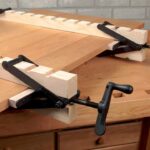Choosing the right woodworking router is crucial for any woodworker. With a plethora of options available in the market, it can be overwhelming to decide which one suits your needs best. However, taking the time to research and make an informed decision can greatly enhance your woodworking experience and project outcomes.
Woodworking routers are versatile tools that have become a staple in every woodworker’s arsenal. They are used for a variety of tasks including shaping, trimming, and cutting materials such as wood, plastic, or even metal. The right router can not only save you time and effort but also ensure precision and accuracy in your work.
Before diving into the world of routers, it is important to assess your woodworking needs. Understanding the role of a router in your projects will help you determine which type of router is best suited for you. Whether you need a plunge router for deep cuts or a trim router for delicate edges, identifying your specific requirements will narrow down your options and make the selection process easier.
In addition to considering your needs, there are several other factors to keep in mind while choosing a woodworking router. Power, speed control, bit capacity, ergonomics, and compatibility with router tables are all crucial aspects that should be evaluated before making a purchase.
By thoroughly researching different brands known for their quality and reliability, reading user reviews and professional opinions, and seeking advice from fellow woodworkers, you can ensure that you choose a router that offers the best value for your investment.
By following these guidelines and taking advantage of hands-on experiences at local woodworking stores, you can confidently select the right woodworking router for successful projects. Remember that choosing the right tool is not only essential for achieving precise results but also enhancing your overall woodworking journey.
Understand your woodworking needs
Woodworking is a versatile craft that requires various tools to create beautiful and functional pieces. One of the most important tools for any woodworker is a woodworking router. A router can perform a wide range of tasks, such as shaping edges, cutting grooves, creating joinery, and even carving intricate details. Therefore, it is crucial to understand your woodworking needs and assess the role of a router in your woodworking arsenal before making a purchase.
First, you should evaluate the projects you typically work on or plan to work on in the future. Are you primarily focused on building furniture, cabinets, or smaller decorative items? Understanding the scale and complexity of your projects will help determine the specific functions and features you need in a router.
For example, if you frequently work with larger pieces of wood or need to make deep cuts, a plunge router with adjustable depth settings would be beneficial. On the other hand, if you mostly work on delicate projects that require precision and control, a trim router might be more suitable.
Additionally, consider the type of joinery techniques you use or plan to use in your woodworking projects. If dovetail joints are common in your work, look for a router that allows for easy installation of dovetail jigs. Similarly, if you frequently use edge profiles or decorative moldings in your designs, choose a router that offers a variety of bit options and has speed control capabilities to achieve different cuts.
Understanding your woodworking needs will not only help you select the right type of woodworking router but also determine the specific features that are important to you. By assessing your projects and considering the role of a router in your woodworking arsenal, you can make an informed decision when choosing the right tool for your craft.
| Factors to Consider | Importance |
|---|---|
| Project scale and complexity | High |
| Required functions and features | High |
| Joinery techniques used | Moderate |
| Type of cuts needed | Moderate |
Types of routers
When it comes to choosing the right woodworking router, it is essential to understand the different types of routers available in the market. Each type has its own unique features and functions that cater to specific woodworking needs. Here are three popular types of woodworking routers:
- Plunge Routers: Plunge routers are versatile tools that allow woodworkers to make plunge cuts or start a cut in the middle of a piece of wood. These routers have a spring-loaded base that can be lowered into the wood at any point during routing. This makes them perfect for creating grooves, mortises, and intricate joinery. Plunge routers also offer depth adjustment features that enable precise control over cutting depths.
- Fixed-Base Routers: Fixed-base routers are known for their stability and accuracy. As the name suggests, these routers have a fixed base that allows woodworkers to set a specific cutting depth before starting a cut. The fixed base ensures consistent results throughout the entire routing process. Fixed-base routers are great for tasks like edge profiling, dadoes, and chamfers.
- Trim Routers: Trim routers, also referred to as laminate trimmers or palm routers, are compact and lightweight. They excel at delicate and detailed work on small projects such as trimming laminate edges or making decorative edges on smaller pieces of wood. With their easy maneuverability and precision control, trim routers are ideal for working with thin materials or executing fine details.
Each type of router offers its own advantages and disadvantages depending on your woodworking projects and requirements. Understanding these differences will help you choose the right router that best suits your needs.
In addition to the types mentioned above, there are also routers that combine features of both plunge and fixed-base routers. These hybrid routers provide the versatility of a plunge router with the stability and accuracy of a fixed-base router. They are suitable for woodworkers who need the best of both worlds.
Before making a decision, it is worth considering the projects you will be working on most frequently and the features that would benefit you. Investing in multiple routers may also be an option if your woodworking needs vary greatly. The key is to have a clear understanding of what each type offers so that you can select the right woodworking router for your specific needs.
Considerations before buying
When it comes to choosing the right woodworking router, there are several important factors that you need to consider. These factors play a crucial role in determining the overall performance and efficiency of the router, as well as how well it will meet your specific woodworking needs. In this section, we will discuss some key considerations that you should keep in mind before making a decision.
Power
One of the most important considerations when choosing a woodworking router is its power. The power of a router is typically measured in horsepower (HP), and it determines how smoothly and effortlessly the router can cut through wood. For smaller projects or occasional use, a lower-powered router may suffice.
However, if you frequently work with hardwoods or larger projects, you’ll want a more powerful router with higher HP. Keep in mind that higher HP routers also tend to be heavier and bulkier.
Speed Control
Another essential feature to consider is speed control. Different woodworking tasks require different speeds for optimal results. A router with variable speed control allows you to adjust the RPM (revolutions per minute) according to the material being cut and the type of cut needed. This flexibility ensures cleaner cuts and reduces chances of burning or damaging the wood.
Bit Capacity
Bit capacity refers to the maximum size of bits that a router can accommodate. It’s crucial to choose a router that can handle various bit sizes since different projects often call for different bit diameters. Ideally, look for routers with at least 1/2 inch collets as they offer greater versatility.
Ergonomics
Comfort is an often overlooked but important factor when selecting a woodworking router. Since woodworking can involve long hours of operation, it’s crucial to choose a router that feels comfortable and balanced in your hands. Look for routers with ergonomic grips and handles that minimize fatigue and wrist strain.
Compatibility with Router Tables
If you plan on using a router table for more precise and controlled cuts, consider the compatibility of the router with router tables. Some routers come with built-in features or attachments that are specifically designed for use with router tables. Ensure that your chosen router can be easily mounted onto a table, allowing you to maximize its versatility.
By carefully considering these factors before buying a woodworking router, you can ensure that you choose a tool that aligns with your specific needs and requirements. Taking the time to research and test different models will pay off in the long run by helping you find the right router that will serve you well in your woodworking endeavors.
Researching router brands
Researching router brands is a crucial step in choosing the right woodworking router for your projects. With so many brands available in the market, it can be overwhelming to determine which one offers the best quality, reliability, and customer support. To make an informed decision, it is important to research reputable router brands that have a proven track record.
When researching router brands, one of the first factors to consider is their reputation for quality. Look for brands that are known for producing durable and long-lasting routers. Reading customer reviews and feedback can provide valuable insights into the performance and durability of a particular brand’s routers. It is also helpful to look for any awards or recognition that the brand has received in the woodworking industry.
Reliability is another important aspect to consider when researching router brands. You want a router that you can rely on to perform consistently and accurately. Look for brands that have a reputation for manufacturing reliable tools that do not break down frequently or require excessive maintenance.
Customer support is also a critical consideration when choosing a woodworking router brand. In case you encounter any issues with your router or need assistance with set up and operation, it is important to have access to prompt and helpful customer support services. Research brands that have positive customer service reviews, as this can make a significant difference in your overall experience with the product.
To summarize, researching router brands allows you to make an informed decision and choose a woodworking router from reputable manufacturers. Consider factors such as quality, reliability, and customer support when evaluating different brands. Reading customer reviews and seeking recommendations from fellow woodworkers can also provide valuable insights into the performance of different routers on the market.
Budgeting for a router
When it comes to choosing a woodworking router, one important consideration is your budget. Woodworking routers can vary significantly in price, so it’s essential to evaluate your budgetary constraints and find a router that offers the best value for your investment.
Before you start researching routers, take the time to determine how much you are willing to spend. Setting a budget will help you narrow down your options and prevent you from overspending.
Keep in mind that while cheaper routers may be more affordable upfront, they may not offer the same level of quality and durability as higher-end models. It’s worth investing a bit more if it means getting a router that will last longer and perform better in the long run.
Once you have determined your budget, start researching routers within that price range. Look for reputable brands known for their quality craftsmanship and reliable performance. Reading customer reviews and professional opinions can also provide valuable insights into the durability and overall performance of different models.
| Router | Price | Key Features |
|---|---|---|
| Brand A Router | $100 | – 1.5 horsepower
|
| Brand B Router | $300 | – 2.5 horsepower
|
| Brand C Router | $500 | – 3 horsepower
|
Remember to prioritize the features that are essential for your woodworking projects. If you are a beginner or only need a router for occasional use, a more budget-friendly option may be suitable. However, if you are a professional or plan on using your router frequently and for complex projects, it may be worth investing in a higher-end model.
By evaluating your budgetary constraints and comparing the features and performance of different routers within your price range, you can make an informed decision and find the best value for your investment.
Reading router reviews
When it comes to choosing the right woodworking router, one of the most important steps is reading router reviews. By taking the time to research and read reviews from users and professionals, you can gain valuable insights into a particular router’s performance and long-term durability. This information can help you make an informed decision and choose a router that will meet your woodworking needs.
Understanding user reviews
User reviews provide firsthand experiences and opinions from those who have used the router in real-world woodworking projects. These reviews often highlight the pros and cons of a specific model, allowing you to see how well it performs in different scenarios. Pay attention to common themes or recurring issues mentioned by multiple users as this can indicate a potential problem with the router.
Another aspect to consider when reading user reviews is the credibility of the reviewer. Look for detailed and well-written reviews that provide specific examples of how the router performed. Be cautious of overly positive or negative reviews that lack substance, as they may not accurately reflect the quality or capabilities of the router.
Considering professional opinions
In addition to user reviews, it’s also beneficial to seek out professional opinions on woodworking routers. Experts in the field often have extensive knowledge and experience with various brands and models, allowing them to offer valuable insights.
Professional reviewers typically conduct thorough tests on routers, evaluating factors such as power, speed control, ergonomics, and compatibility with accessories like router tables. Their in-depth analysis can help you understand how well a specific model performs compared to others on the market.
When reading professional opinions, consider multiple sources to get a well-rounded view. Different experts may prioritize different features or have varying perspectives based on their own preferences and requirements. By gathering information from several reliable sources, you can form an informed opinion about which woodworking router is best suited for your needs.
Reading user reviews and professional opinions is an essential step in choosing the right woodworking router. By gaining insights into a router’s performance and long-term durability, you can make an informed decision that aligns with your woodworking needs. Remember to consider both user reviews and professional opinions, as they provide different perspectives that can help you find the perfect router for your projects.
Seek advice from woodworking community
Engaging with the woodworking community is an excellent way to gather valuable insights and recommendations when it comes to choosing the right woodworking router. Woodworkers with experience can provide guidance based on their own experiences, helping you make an informed decision. Whether you interact with the community through online forums, social media groups, or in person at woodworking clubs or workshops, seeking advice from fellow woodworkers can be immensely beneficial.
When engaging with the woodworking community, consider asking specific questions about routers that align with your needs and projects. For example, if you primarily work on large-scale projects, ask for recommendations on routers that have enough power and speed control to handle heavy-duty tasks efficiently. If you are new to woodworking and looking for a versatile router suited for various projects, seek advice on models that offer ease of use and compatibility with different types of bits.
Another advantage of engaging with the woodworking community is discovering any common issues or problems woodworkers may have faced with certain routers. This information can alert you to potential drawbacks or limitations of specific models and help steer you away from them if they do not meet your requirements.
Lastly, participating in discussions within the woodworking community allows you to learn from other woodworker’s experiences and gain insider knowledge about various brands and models available in the market. You can gain a better understanding of which manufacturers are known for producing reliable routers, offering good customer support, and releasing firmware updates regularly. By tapping into this collective wisdom, you increase your chances of finding a quality router that meets your needs effectively.
Hands-on experience
One of the most important steps in choosing the right woodworking router is getting hands-on experience with the different options available. While online research and reading reviews can provide valuable information, nothing beats testing out the routers in person at a local woodworking store. This allows you to assess their features, comfort, and overall feel before making a purchase.
When trying out different routers, it’s essential to pay attention to their features. Look for routers that have the specific functions and capabilities you need for your woodworking projects. For example, if you frequently work on intricate designs, a router with precise depth adjustment and fine control may be more suitable for you. Similarly, if you often work with larger pieces of wood, consider routers with larger base plates and more power.
Comfort should also be taken into consideration during your hands-on experience. Pick up each router and get a feel for its weight, balance, and grip. Woodworking can be physically demanding, so choosing a router that feels comfortable in your hand is crucial to prevent fatigue or discomfort during long hours of use.
Overall feel is another important factor to evaluate when trying out different routers. Consider how smoothly the router handles and operates. Pay attention to any vibrations or noise produced by the router as well. A smooth and quiet operation indicates better overall quality and performance.
Trying out routers in person also allows you to take note of any additional features or accessories that may come with the router. Some models may include extras such as dust collection systems or LED lights that can enhance your woodworking experience.
Conclusion
In conclusion, choosing the right woodworking router is crucial for any woodworker, as it plays a vital role in achieving successful projects. Throughout this article, we have discussed various important points to consider when selecting a router.
Firstly, understanding your woodworking needs is essential. Assessing your projects and determining the specific role of a router in your woodworking arsenal will help you narrow down your options and choose the most suitable type of router for your needs. Exploring different types of routers such as plunge routers, fixed-base routers, and trim routers can further assist in making an informed decision.
Before making a purchase, it is important to carefully consider certain factors. These include power, speed control, bit capacity, ergonomics, and compatibility with router tables. By prioritizing these considerations based on your specific requirements, you will be able to find a router that offers the best value for your investment.
Additionally, researching reputable brands known for their quality and reliability is crucial. By choosing a trusted brand with good customer support, you can have peace of mind knowing that you are investing in a reliable tool that will last for years to come.
Reading user reviews and seeking advice from the woodworking community are also valuable steps. Listening to others’ experiences can provide insights into a particular router’s performance and long-term durability. Finally, don’t underestimate the importance of hands-on experience. Trying out different routers in-person at a local woodworking store allows you to assess their features, comfort level, and overall feel before making a final decision.
Frequently Asked Questions
How do I know what wood router to buy?
Choosing the right wood router requires considering several factors. Firstly, determine your specific woodworking needs and preferences, whether you’re a beginner or have more experience. Consider the power of the router – higher horsepower routers are suitable for heavy-duty tasks, while lower horsepower models are more appropriate for lighter projects.
Additionally, think about the type of router base you prefer: fixed base routers provide stability, while plunge routers offer versatility in depth adjustments. Consider the speed options available as well since variable speed routers allow greater control over different materials. Researching user reviews and consulting with experienced woodworkers can also help you make an informed decision.
Should I buy a 1 2 or 1 4 router?
Deciding between a 1/2 router or 1/4 router depends on the scope of your woodworking projects. A 1/2 router typically offers more power and is recommended for heavier workpieces or extensive routing tasks due to its larger collet size and ability to handle bigger bits. This makes it suitable for professional woodworkers or those undertaking complex projects like cabinetry or large-scale furniture making.
On the other hand, a 1/4 router is generally smaller and lighter, making it easier to maneuver and control when working on intricate designs or smaller wood pieces. If you primarily work on small-scale projects or require more precision and finesse, a 1/4 router may be sufficient.
How strong of a wood router do I need?
Determining how strong of a wood router you need relies on the nature of your woodworking projects and the materials you typically work with. Consider both horsepower (HP) and variable speed options when assessing strength requirements – higher HP ratings indicate a more powerful motor that can handle tougher tasks and harder woods efficiently.
If you frequently work with denser woods like oak or maple or undertake demanding cuts such as deep grooves or large dadoes, investing in a stronger wood router would be beneficial for productivity and performance purposes. However, if your projects mainly involve softer woods or lighter routing activities like edging or decorative work, a less powerful router may be sufficient while offering more control and maneuverability.

Hi everyone! I’m a woodworker and blogger, and this is my woodworking blog. In my blog, I share tips and tricks for woodworkers of all skill levels, as well as project ideas that you can try yourself.





